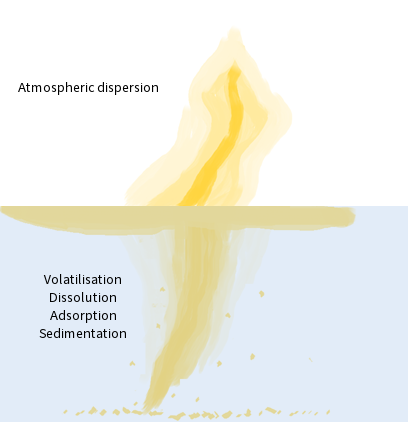
Improving Member States preparedness to face an HNS pollution of the Marine System (HNS-MS)
Mathematical modelling
During a spill, the focus is generally on floaters and evaporators substances types, because of its visibility and short term impact at the sea surface. Not only considering the surface slick fate with the updated OSERIT drift model, the HNS-MS project will treat as well the behavior of the chemicals in the water column whether due to entrainment from breaking waves, or in the case of a leakage from a sunken vessel, a broken pipeline/well head.
For these scenarios, the subsea plume will be modeled from the source to the surface. During the plume ascent, the following aspects will be taken into account: the plume dynamic stage near the release source, the environmental conditions (currents, temperature, etc.) on the transport of the particles, the droplets/bubbles size distribution and slip velocity, and processes such as volatilization, sedimentation and eventually degradation. For different types of HNS, particles will be tracked to provide to OSERIT the spatial and temporal quantities of chemicals reaching the surface, necessary to predict the spill fate.
A particular attention will be paid on the underwater fate of dissolvers substances: when soluble liquids or gaseous are involved in the spill, the dissolution mechanism cannot be neglected as it implies a high potential risk of toxicity and absorption by flora and fauna regardless to areas with human presence or protected natural site. An important part of the HNS-MS project is dedicated to its task through the understanding and the modeling of the dissolution of soluble liquids (and gases) processes: A quantification of the transferred matter from droplets/bubbles to the surrounding environment (and by extension to the sediments) will be evaluated, through a modeled dissolution rate/mass fraction. The model will be faced with results from dedicated laboratory experiments, to ensure its good agreement.
The third "compartment", namely the atmosphere, will be also treated. Chemicals of evaporators type, passing from the sea surface to the air, represent a crucial issue: Not only for operational people on site regarding to the multiple risks (fire, explosion, hazards inhalation, etc.), but also in general for the human health of population, as meteorological conditions can make the cloud move toward inhabited land.
The HNS-MS project will include an atmospheric dispersion model, able to provide a "first line information". The trajectory and the spatial extent of the cloud will be estimated, taking into account the wind and other atmospheric parameters. The gas concentration in this plume will be also given. This information will allow authorities to evaluate the potential risks on the population.

About the project
HNS-MS is a decision-support tool that Belgian and French maritime authorities as well as coastguard stations can activate in order to forecast the drift, fate and behavior of acute marine pollution by Harmful Noxious Substances (HNS) accidentally released in the marine system.
Contact us
Copyright © 2015–2025 HNS-MS Consortium
 HNS-MS has been funded by DG-ECHO under agreement ECHO/SUB/2014/693705 and runs from 1 January 2015 to 31 March 2017.
HNS-MS has been funded by DG-ECHO under agreement ECHO/SUB/2014/693705 and runs from 1 January 2015 to 31 March 2017.